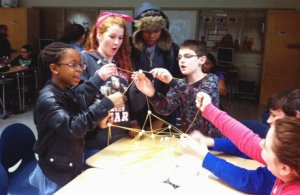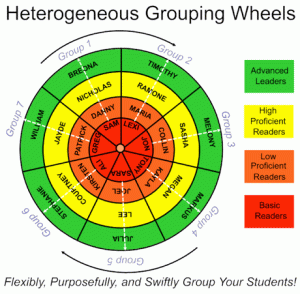5 More Ways to “Remove the Walls” From Your Classroom
Here are five more ways to rearrange students across the usual groupings and grade levels while differentiating, hitting the standards, ensuring proficiency, and boosting engagement.
Do you play well with others? OK, let's see. You meet with your colleagues, share resources, divvy up tasks, discuss student concerns -- and then you go back to your room to teach the same differentiated lesson as the rest of your team. Is this true collaboration?
Mastering the collaborative arts requires you to approach instruction with the same all-hands-on-deck group mindset that drives your planning meetings. Flexibly grouping students between classrooms saves time and boosts achievement. In my post Five Ways to "Remove the Walls" from Your Classroom, I highlighted five collaborative grouping strategies to help you work smarter, not harder. Below are five more.
1. Preteach skills and content through quick, differentiated activator mini-lessons.
Preteaching increases student independence and lesson mastery by leveling the playing field initially. Whether with a full class or small group, spending a little instructional time to fill knowledge gaps or prime specific skills for an upcoming lesson can pay massive dividends in the end.
At the beginning of each unit, my grade-level team would analyze our students' pre-assessment results, which included questions measuring their prior knowledge of new unit standards. Along with prior summative and periodic formative assessment results and IEP/ELL/504 goals, we planned activator groups to fill the students' content or skills gaps for upcoming lessons. Here's how this looks in practice: While you pool students from across the grade level to build skill deficits, have another teacher prep advanced students to lead their assigned groups (including students from your pullout) during the subsequent lesson.
Think of your classroom as a business. Investing in the small setup cost (time) of priming your students will highly increase class productivity by minimizing your need to reteach later on. Spend a little, gain a lot!
2. Catch your students up through the 3 R's: Reteach, Redo, Reward.
It’s no secret: students learn and work at different paces. With differentiation, seasoned teachers help their students master content, processes, and skills through diverse paths. However, all students have the same deadlines to complete projects and assignments with identical summative assessments. How can we ensure that all students meet those deadlines while also encouraging the advanced, productive learners? Don't be afraid to plan a strategic catch-up day with colleagues. If done purposefully, this is time well spent.
Last year, we found this to be helpful at my school. On the day before spring break, my seventh-grade math team strategically regrouped students between our classes. Teachers sent students with missing assignments to one classroom, while I retaught students who struggled with certain lesson standards. However, many students were motivated to join the board game/movie reward group, so they worked hard over a two-week period to turn in all assignments and attended tutoring as needed. Once again, this leveled the playing field. Students in the smaller reteach group progressed toward mastery, while those in the redo group bumped up their grade through individualized assistance to complete missing assignments. Even though not all students earned the behavioral incentive, overall behavior improved in the weeks leading up to spring break.
Alternatively, you could productively engage your fast-paced, advanced students in an extension project during a reteach-redo make-up day. A behavioral incentive successfully motivates students and increases attendance on days before semester breaks when many would otherwise skip.
3. Engage students in differentiated station rotations.
Our students were born into a fast-paced, constantly-evolving, technology-driven culture that has overturned the rules of business, communication, and (most importantly) education. In this new environment, how can we possibly continue raising the bar and integrating all of the latest and greatest educational initiatives while our students have the attention span of a gnat?
Simple. Meet them where they are! Rotate your kiddos between short, differentiated, student-led stations. Consider building all of your school's new instructional initiatives (cloze reading, writing, technology integration, etc.) into individual stations. Jigsaw lessons with leveled readings, differentiate for learning styles or preferences, integrate technology, provide real-world extensions, or prep for a test.
Save time by collaborating with your teammates to develop the stations. While you work smarter, your students work harder!
4. Challenge your students through cross-curricular projects.
One of the most exciting yet daunting parts of Common Core is its interdisciplinary approach. What does it look like to weave literacy, writing, mathematical skills, and real-world application throughout all classes? And where do we find the time?
For one, you could challenge your students through research-based projects with a common rubric. Last year, my seventh-grade science team gave our students the choice of completing the science fair, researching the biography of a famous scientist, or writing a report on a STEM-related career. On project days, the students traveled to the classroom of the teacher facilitating that topic.

For secondary schools, teachers can coordinate an interdisciplinary project that aligns with standards from each core (and possibly some encore) class. For example, task your science class with persuasively arguing whether Pluto should or should not be considered a planet through a research-based interdisciplinary project. The students will research their claim and supporting details in science, write the persuasive essay in language arts class, develop an annotated bibliography in social studies, and construct figures and captions with relevant interpretations in math. Each teacher will grade a different part of the project based on a unique rubric. Lastly, keep in mind that your media/library specialist is a great resource to help your team gather necessary books and other research materials.
5. Build a teacher toolbox of quick, flexible grouping strategies.
Below you will find a few of my favorite strategies for flexible grouping.
Interactive student folders
This system helps students easily organize their work and complete long-term projects. At the beginning of the year, use each student's previous testing results to purposefully assign them an interactive work folder:
- Blue folder = basic in math and reading
- Red folder = basic in math but proficient in reading
- Orange folder = basic in reading but proficient in math
- Yellow folder = proficient in math and reading
- Green folder = advanced in math and reading
Simply "rainbow" the folders for heterogeneous group projects or classroom assignments by ensuring that the folder colors are evenly divided.
Desktop index cards
Taping these cards to each student's desk provides a secretly-coded individual profile to plan groupings. Use stickers, colors, and shapes to indicate reading and math readiness levels, specific goals, learning styles, and other important defining characteristics. Get creative. Try grouping your students with the same shape for leveled reading assignments, or combining preferred learning styles by telling your students to find a partner with a different sticker. The possibilities are endless!
Heterogeneous student grouping wheels
This system equitably groups students by separating conflicting personalities, distributing advanced student leaders, and mixing multiple academic readiness levels. The wheel below demonstrates how I split my class into seven groups of four. Create your own by inserting a copper brad through the center of different-sized circular cutouts.

Give it a try!
Take your instruction to the next level by collaborating with your colleagues to remove the borders from your classrooms. We must reach all students. Learning has no walls!
